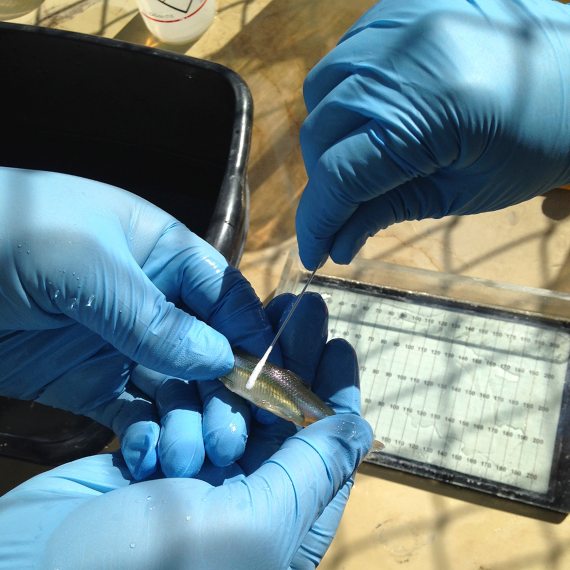CRISPR. Only the most expert among us can remember the full name behind this acronym, but many already know that it is the molecular tool that has revolutionised genetic engineering so far in the 21st century, even more so when its two main creators have just been awarded the Nobel Prize for Chemistry in 2020. The potential of this novel system of genetic cut-and-paste has already been amply demonstrated in research, and it holds great promise in biomedicine. But there is another field of application in which CRISPR can also make a difference: environmental conservation, including the fight against climate change.
One of the keys to CRISPR is that it allows changes to be made to a genome without introducing marker genes. More classic techniques need to add certain external genes during the process of building the new fragments, for example antibiotic resistance genes, whose use carries the risk of reducing the effectiveness of these drugs. This is one of the drawbacks that has limited the expansion of transgenic crops.
For this reason, researchers are working on obtaining modified plant varieties using CRISPR, without transgenes. This has resulted in a line of virus-resistant cucumbers, a tomato strain with improved growth, and a type of rice resistant to a damaging fungus, among many other examples. For Chinese Academy of Sciences biotechnologist Caixia Gao, “CRISPR technology is erasing barriers to genome editing and could revolutionize plant breeding.” And although the technical challenges are compounded by regulatory uncertainty, according to Gao the fact that the crops obtained do not contain transgenes likens them to those that could be obtained by traditional methods, so that they “would not need to be equated with genetically modified organisms.”
Low-emission agriculture and livestock
CRISPR also has a field of application in reducing greenhouse gas emissions from agriculture and livestock. Flooded rice fields are the largest anthropogenic source of methane. Genetic techniques have previously been applied to produce low-emission varieties, a goal now made more attainable by CRISPR. Work is even underway to develop varieties of grass that are easier for cows to digest, with the dual aim of reducing methane emissions generated by digestion and boosting milk production.
The modification of microorganisms by CRISPR offers countless possibilities for the use of these cells as biological factories with worthwhile environmental functions. Thus, the use of nitrogen fertilizers in agriculture can be reduced by genetically enhancing the fixation of this nutrient by the microbes that grow in association with the plants. The genetic modification of a seaweed using CRISPR has managed to double its lipid production, a laudable achievement in the manufacture of biofuels. While the production of these fuels has been called into question because of the large areas of land occupied by the crops used to produce them, that objection falls away if the raw material can be grown in algae bioreactors.

CRISPR could also help certain species adapt to climate change. One example has been explored by researchers at the University of New South Wales in Australia. There, the reefs of the Great Barrier Reef are threatened by bleaching due to warming waters, which expel from coral tissues the symbiotic single-cell Symbiodinium algae, which provide food through photosynthesis. Australian scientists propose using CRISPR to introduce into the genome of local varieties of this algae the genes needed to increase their resistance to higher temperatures. “Environmental bioengineering is an alternative strategy to safeguard against climate change,” the authors write.
Gene drives to eliminate invasive predators
This correction of genes for environmental purposes is an option that has been discussed in recent years because of the potential of CRISPR in gene drives; this name refers to the use of certain genetic mechanisms that allow the alteration of the genome of individuals of a species so that this modification ends up being imposed on the population over several generations, thanks to the ability of the mechanism introduced to self-perpetuate. In nature there are gene drive systems, but CRISPR offers a way of introducing them easily at will by inserting a gene together with the cut-and-paste elements that will make the desired change in each successive generation.
For example, New Zealand aims to eliminate all invasive predators by 2050, and has considered doing so through gene drives, for example by inserting genes that reduce the fertility of rats. However, scientists such as biotechnologist Kevin Esvelt, who was in fact one of the pioneers in developing CRISPR and proposing its use for gene drives, have warned of the ecological risk of releasing these systems into the wild, as it would be tantamount to creating a new invasive species. “We need open and international discussions concerning a technology that could have global ramifications,” wrote Esvelt and his colleague Neil Gemmell.

The truth is that CRISPR has turned out to be much more than the molecular scissors to which it is often referred; its ability to locate specific genetic sequences opens the door to using this tool in the detection and identification of genomes. A current example is its use for the creation of fast and cheap COVID-19 tests. In the environmental field, a team from the University of California has adapted a platform based on CRISPR called SHERLOCK (Specific High-sensitivity Enzymatic Reporter Unlocking) to identify in situ the pond smelt (Hypomesus transpacificus), an endemic fish of the San Francisco estuary, now under threat.
“We’ve shown that SHERLOCK can be used without a DNA extraction for certain samples like fish mucus, and in that case the whole process can be as quick as 20-30 minutes,” study co-author Andrea Schreier told OpenMind. The test identifies the species using a portable fluorescent reader or a strip of paper like in pregnancy tests. In this way, researchers can quickly distinguish native fish from another invasive Japanese species that looks very similar. “CRISPR can do a lot more than edit genomes. It can be used for some really cool ecological applications,” says Schreir. According to the researcher, “SHERLOCK and other CRISPR based platforms can be used at border crossings or other inspection points to identify mislabelled fish and wildlife products.”
Javier Yanes
Comments on this publication